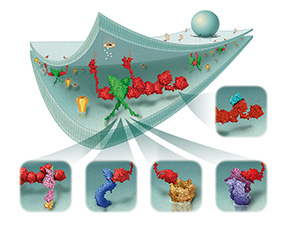
Neurexins and their postsynaptic interaction partner neuroligins represent an ideal candidate pair for a role in the formation and/or maturation of synapses due to their heterotypic, presumably transsynaptic binding that reflects the asymmetric nature of the synapse.
In one branch of the project we aim to describe the structural determinants of the extracellular domains of α- and β-neurexins that are required for binding, and therefore, to sustain their important functions. For example, we explored the structure of the Nrxn/Nlgn binding interface at the single-amino acid level in mutagenesis experiments, identifying an essential hydrophobic contact area that surrounds a Ca2+ coordination pocket (see Reissner et al., 2008). Furthermore, we combine currently available data into a model of the overall structure of α-Nrxn along with its binding sites to neuroligin, α-dystroglycan, heparin, and neurexophilin.
In a second branch of the project we are interested in how neuronal cells deliver presynaptic cell-surface molecules to synaptic contacts. Applying cell biological methods, e.g. neuronal cell cultures (primary dissociated neurons and long-term organotypic slice cultures), immunocytochemistry, confocal/conventional fluorescence microscopy and live-cell imaging, we study the targeting of neurexins and neurexophilins to the synapse (see Fairless et al., 2008). We now study how their polarized distribution is accomplished and what molecular mechanisms are involved. We also investigate how the targeting and presentation on the axonal surface relates to their role in synaptic transmission and synapse formation.

